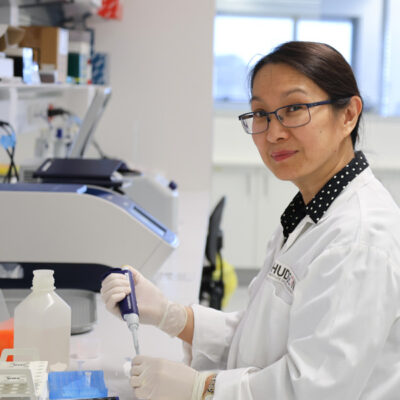Progressing solutions for endometriosis
By Hudson Institute communications
Approximately one in 10 Australian women and many teenage girls live with a ‘silent’ yet potentially debilitating condition, endometriosis. Endometriosis can affect a woman’s physical and mental health, impacting on their ability to work and study, as well as disrupting family life and personal relationships.

Head of the Endometrial Stem Cell Biology laboratory at Hudson Institute, Professor Caroline Gargett, says the effects of endometriosis are far-reaching.
“Despite extensive work by researchers all over the world, the cause of endometriosis remains largely unknown. There is still no early diagnostic test, and women can wait 7 to 10 years to receive a diagnosis. The symptoms of endometriosis, including chronic pelvic pain, nausea and pain during sex, can be debilitating,” Prof Gargett says.
What is endometriosis?
- Endometriosis is a condition in which tissue that lines the uterus grows outside of the womb, causing lesions elsewhere in the body.
- Symptoms of endometriosis can include pelvic pain, bowel problems, nausea and pain during sex. Around a third of women with endometriosis experience infertility.
- It is still not known what causes endometriosis. There is no cure for the disease.
- Its estimated prevalence in women is similar to that of diabetes, Crohn’s disease and rheumatoid arthritis, yet the full socioeconomic impact is underestimated.
- A 2014 University of Sydney study found that endometriosis costs Australian society $7.7 billion a year, with two-thirds of that attributed to lost productivity and the remaining $2.5 billion to direct healthcare costs.
Reducing the impact of endometriosis through research
Surgical intervention is the main way of diagnosing endometriosis, and it is also the main form of treatment.
“We want to better understand why endometriosis occurs, and how we can better treat and detect the disease earlier, to reduce suffering for women,” says Dr Jemma Evans, a senior scientist in Hudson Institute’s Endometrial Remodelling laboratory.
Researchers at Hudson Institute are working on developing non-surgical solutions, non-hormonal treatments and minimally invasive diagnostics, and to better understand the causes of endometriosis, to reduce its impact on women’s lives and the health system.
Progress and solutions
Our scientists are examining the role of endometrial stem cells in endometriosis; analysing proteins found in the womb to develop a test for detecting endometriosis as a cause of infertility; and are working towards an early detection test for the condition.
Evelyn, a 34-year-old Melbourne woman with a form of severe endometriosis, is one of many affected women who want the condition recognised as a priority relative to its impact on women’s lives.
“For a condition that affects 1 in 10 women globally, I believe there should be a greater urgency in the funding sectors to make endometriosis a curable disease and to make women’s health a top priority.”
“When a disease affects around 10 per cent of all women of reproductive age, it’s not just ‘women’s problems’, it touches everyone. Through women ‘speaking up’, and with support and understanding from the general public, this will help to create progress and solutions for endometriosis,” Dr Evans says.
About Hudson Institute
Hudson Institute’ s research programs deliver in three areas of medical need – inflammation, cancer, women’s and newborn health. More
Hudson News
Get the inside view on discoveries and patient stories
“Thank you Hudson Institute researchers. Your work brings such hope to all women with ovarian cancer knowing that potentially women in the future won't have to go through what we have!”






